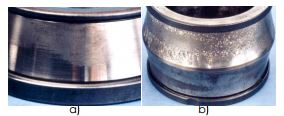Vibration Analysis of Electric Motor
Vibration Analysis on electrical motor gives information about,

Unbalanced Rotor: The rotor gets unbalanced due to improper balancing of rotor, incorrect assembly, corrosion, bent shaft, rotor sagging, material built up, component loss, material deflection, thermal growth etc.
Electrical Problems – Broken/Cracked Rotor Bar Winding: In large motors, those has frequent starts & stops under load, places heaviest stress on rotor bars, hence uneven heating & uneven expansion in turn lead to cracking og rotor bars. After crack develops the resistance of that bar increases, increases the heating at that point and hence, worsening/ widening the crack.
Uneven Gap between Stator & Rotor: Uneven air gap is a result of improper mounting of the end shields, eccentric rotor, cocked bearings, bent shaft, rotor pull-over, bearing housing oversized etc.


Failed/Faulty Bearings: There are many reasons why bearings are getting faulty. Over-Lubricating, Under-Lubricating, Excessive Loads, True Brinelling, False Brinelling, Normal Fatigue Failure (Spalling), Reverse Loading (for angular contact bearings, Lubricant Contamination, corrosion, Misalignment, Loose fits, Tight Fits, Soft Foot, Improper mounting, Electrical Damage (fluting), Defective Sealing, High Temp of rotor, Improper storage etc.
Eccentric Rotor: The rotor of motor goes eccentric, due to improper mounting of motor with bedplate, out of roundness during construction of rotor, improper tensioning of drive belts coupled to a motor, distorted end bells/cocked bearings or a bent shaft, Uneven Magnetic Pool, Rotor Pool over etc.


Bent Shaft: The shaft of motor gets bent due to many causes, like misalignment, improper handling, impact during operation, elevated temperature during operation, faulty methods of bearing removal & refitting. The consequences of bent shaft are shaft misalignment, damage to coupling/seals/ bearings, material fatigue, eccentric rotor etc. This may lead to catastrophic failure of the motor.


Misalignment with driven equipment: The misalignment in equipment causes due to inaccurate assembly, relative position of components shifting after assembly, distortion due to forces exerted by piping, distortion/damages of flexible mountings, coupling face not perpendicular to the shaft axis, Soft Foot, distorted base rail, thermal expansion etc.

Unbalanced Rotor: The rotor gets unbalanced due to improper balancing of rotor, incorrect assembly, corrosion, bent shaft, rotor sagging, material built up, component loss, material deflection, thermal growth etc.


Electrical Problems – Broken/Cracked Rotor Bar Winding: In large motors, those has frequent starts & stops under load, places heaviest stress on rotor bars, hence uneven heating & uneven expansion in turn lead to cracking og rotor bars. After crack develops the resistance of that bar increases, increases the heating at that point and hence, worsening/ widening the crack.


Uneven Gap between Stator & Rotor: Uneven air gap is a result of improper mounting of the end shields, eccentric rotor, cocked bearings, bent shaft, rotor pull-over, bearing housing oversized etc.


Failed/Faulty Bearings: There are many reasons why bearings are getting faulty. Over-Lubricating, Under-Lubricating, Excessive Loads, True Brinelling, False Brinelling, Normal Fatigue Failure (Spalling), Reverse Loading (for angular contact bearings, Lubricant Contamination, corrosion, Misalignment, Loose fits, Tight Fits, Soft Foot, Improper mounting, Electrical Damage (fluting), Defective Sealing, High Temp of rotor, Improper storage etc.


Eccentric Rotor: The rotor of motor goes eccentric, due to improper mounting of motor with bedplate, out of roundness during construction of rotor, improper tensioning of drive belts coupled to a motor, distorted end bells/cocked bearings or a bent shaft, Uneven Magnetic Pool, Rotor Pool over etc.
